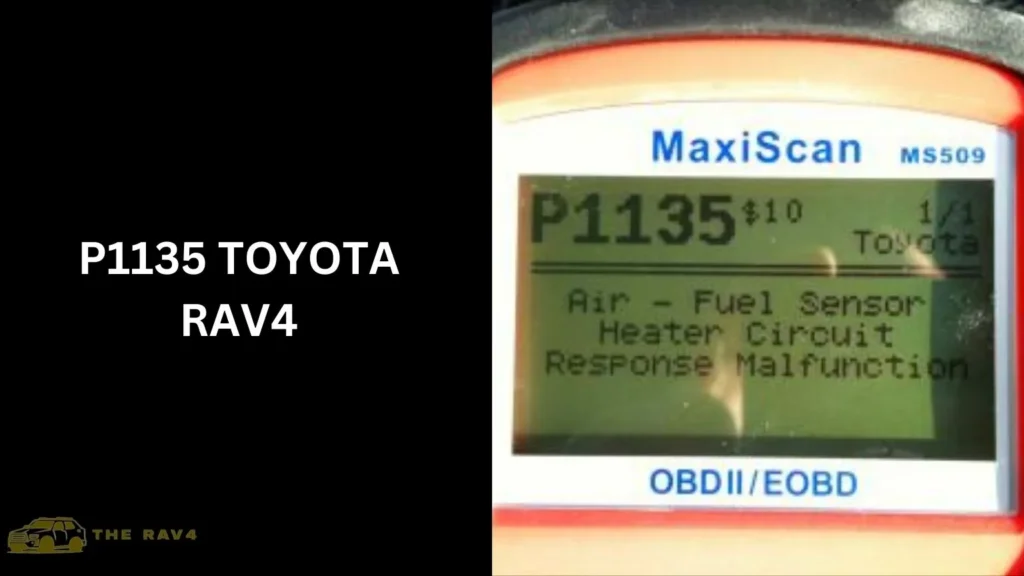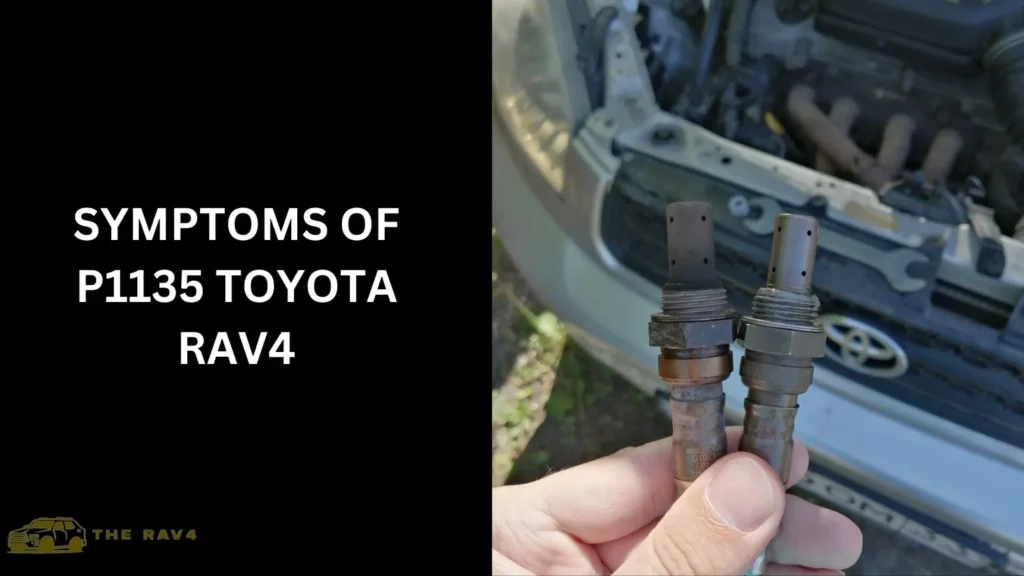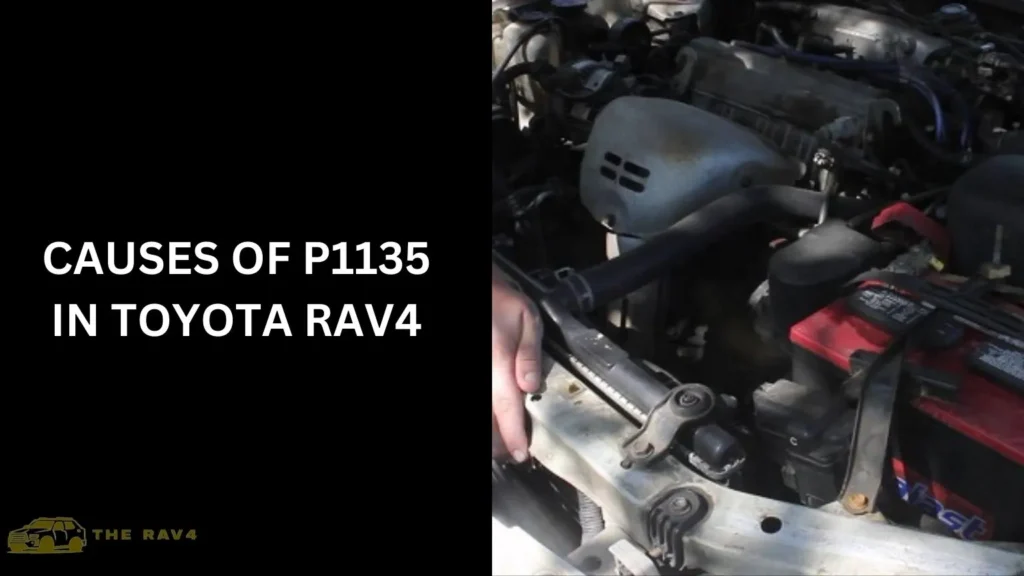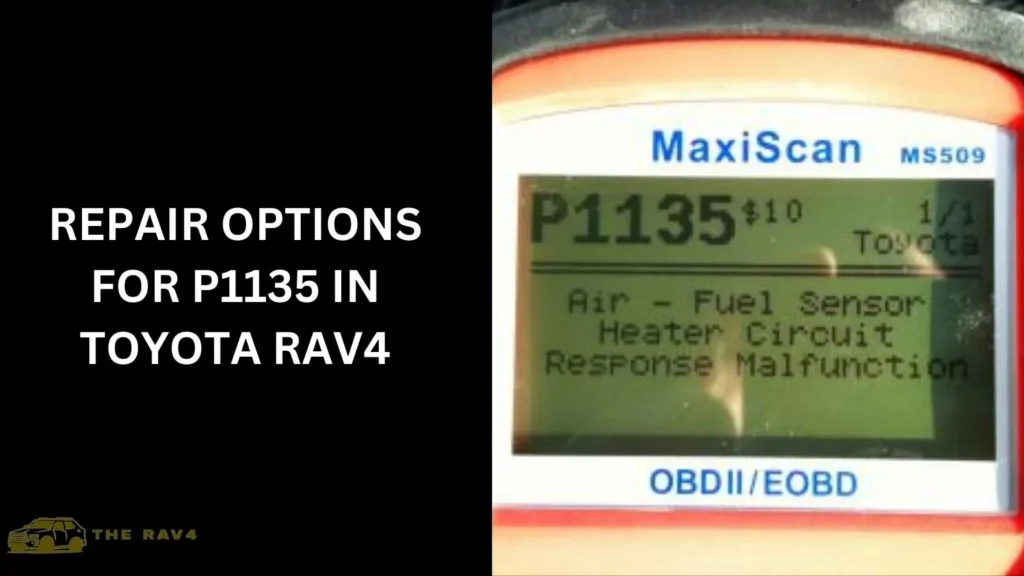Code P1135 Toyota RAV4 (Meaning, Causes & Fixing) of 2024
The Toyota RAV4 is a popular SUV known for its reliability and performance. However, like any vehicle, it can experience issues over time.
One common problem that RAV4 owners may encounter is the code P1135 Toyota RAV4, which relates to the vehicle’s oxygen sensor.
In this article, we’ll delve into what the P1135 code means, its symptoms, causes, diagnostic process, repair options, maintenance tips, and more.

Introduction to the Toyota RAV4
The Toyota RAV4, introduced in 1994, quickly gained popularity as a compact crossover SUV. It has undergone several generations of improvements,
becoming a top choice for families and adventure-seekers alike. With its blend of versatility, comfort, and fuel efficiency, the RAV4 continues to be a bestseller in its class.
Understanding the P1135 Code
In modern vehicles like the Toyota RAV4, onboard diagnostics (OBD-II) play a crucial role in monitoring the vehicle’s systems.
When a fault is detected, the OBD-II system generates a trouble code to indicate the issue. The P1135 code specifically pertains to the oxygen sensor in bank 1, sensor 1.
Symptoms of P1135 Toyota RAV4

The symptoms of a P1135 code in a Toyota RAV4 can vary depending on the specific issue causing the code to trigger.
However, there are some common signs that drivers may notice, indicating a potential problem with the oxygen sensor or related components:
Check Engine Light (CEL) Illuminated
One of the primary indicators of a P1135 code is the illumination of the Check Engine Light on the vehicle’s dashboard.
The CEL serves as a warning that there is a malfunction or fault detected within the engine or emissions system.
Decreased Fuel Efficiency
A faulty oxygen sensor can lead to incorrect readings of the air-fuel mixture, resulting in reduced fuel efficiency.
RAV4 owners may notice that their vehicle is consuming more fuel than usual, requiring more frequent refueling.
Rough Idling or Engine Misfires
An oxygen sensor that is not functioning properly can cause irregularities in the engine’s operation, leading to rough idling or engine misfires. These issues can manifest as noticeable vibrations or hesitation during acceleration.
Reduced Engine Performance
As the oxygen sensor plays a crucial role in regulating the air-fuel ratio for optimal combustion, a malfunctioning sensor can result in decreased engine performance.
This may be evident through sluggish acceleration, lack of power, or difficulty maintaining consistent speeds.
Excessive Exhaust Emissions
In some cases, a P1135 code can lead to an increase in harmful emissions from the vehicle’s exhaust system. This can contribute to environmental pollution and may cause the RAV4 to fail emissions tests.
Causes of P1135 in Toyota RAV4

The P1135 code in a Toyota RAV4 is related to the oxygen sensor, specifically in bank 1, sensor 1.
This code indicates a malfunction or issue with the oxygen sensor’s performance. Several factors can contribute to the triggering of the P1135 code in an RAV4:
Faulty Oxygen Sensor
One of the most common causes of a P1135 code is a faulty oxygen sensor (also known as an O2 sensor).
Over time, these sensors can degrade or fail, leading to inaccurate readings of the air-fuel mixture. A malfunctioning oxygen sensor can affect engine performance and emissions.
Wiring Issues or Sensor Connections
The oxygen sensor relies on electrical connections to transmit data to the vehicle’s engine control module (ECM).
Damaged or corroded wiring, as well as poor sensor connections, can disrupt the sensor’s operation and lead to the P1135 code being triggered.
Engine Problems Affecting Air-Fuel Ratio
Issues within the engine, such as vacuum leaks, intake manifold leaks, or problems with fuel injectors, can impact the air-fuel ratio.
An incorrect air-fuel mixture can cause the oxygen sensor to detect abnormal readings, resulting in the P1135 code.
Exhaust System Leaks or Damage
Leaks or damage to the exhaust system can introduce outside air into the exhaust stream, affecting the oxygen sensor’s readings. This can lead to discrepancies in oxygen levels and trigger the P1135 code.
Sensor Aging or Contamination
Over time, oxygen sensors can become less responsive or contaminated with deposits from exhaust gases.
This can interfere with their ability to accurately measure oxygen levels and contribute to the P1135 code.
Faulty ECM
In rare cases, a malfunctioning engine control module (ECM) or electronic control unit (ECU) can send incorrect signals to the oxygen sensor, leading to the P1135 code being falsely triggered.
Diagnostic Process for P1135
Diagnosing a P1135 code in a Toyota RAV4 involves a systematic process to identify the underlying issue with the oxygen sensor or related components.
Here is a step-by-step diagnostic process that technicians typically follow:
Retrieve the Trouble Code
The first step is to use an OBD-II scanner to retrieve the P1135 trouble code from the vehicle’s onboard computer. The code will indicate a problem with the oxygen sensor in bank 1, sensor 1.
Inspect Wiring and Connections
Check the wiring harness and connections related to the oxygen sensor. Look for signs of damage, corrosion, or loose connections that could be affecting the sensor’s operation. Repair or replace any damaged wiring as needed.
Test Oxygen Sensor Functionality
Use diagnostic tools, such as a multimeter or scan tool, to test the functionality of the oxygen sensor.
Measure the sensor’s voltage output and response time to changes in the air-fuel mixture. Compare the readings to the specifications provided by the manufacturer.
Check for Vacuum Leaks
Inspect the engine for vacuum leaks, which can affect the air-fuel ratio and cause erroneous readings from the oxygen sensor. Use a smoke machine or propane enrichment tool to detect leaks and repair them accordingly.
Verify Air-Fuel Ratios
Use a fuel pressure gauge and exhaust gas analyzer to verify the air-fuel ratios in the engine. Ensure that the engine is operating within the specified parameters and that there are no issues affecting the fuel delivery system.
Check for Exhaust System Leaks
Inspect the exhaust system for leaks or damage that could be affecting the oxygen sensor’s readings. Repair any leaks or replace damaged components in the exhaust system.
Perform Functional Tests
Conduct functional tests on the oxygen sensor and related components to ensure proper operation. Test the sensor’s response to changes in engine load, RPM, and operating conditions.
Monitor Sensor Data
Use real-time data monitoring tools to observe the oxygen sensor’s performance while the vehicle is running. Look for any irregularities or fluctuations in sensor readings that could indicate a problem.
Clear Codes and Test Drive
After making any necessary repairs or adjustments, clear the P1135 code from the vehicle’s computer using the OBD-II scanner.
Take the vehicle for a test drive to confirm that the code does not reappear and that the engine is operating normally.
Repair Options for P1135 in Toyota RAV4

When dealing with a P1135 code in a Toyota RAV4, there are several repair options depending on the root cause of the issue.
Here are some common repair solutions that technicians may consider:
Replace the Oxygen Sensor
If the diagnostic process confirms that the oxygen sensor in bank 1, sensor 1 is faulty or malfunctioning, the recommended course of action is to replace the sensor.
This involves removing the old sensor and installing a new, OEM-approved sensor that meets the vehicle’s specifications.
Repair Wiring or Connections
If the P1135 code is triggered by damaged wiring, corroded connections, or poor electrical conductivity, technicians will repair or replace the affected wiring and connections. This ensures that the oxygen sensor receives accurate signals and operates correctly.
Address Engine Issues
If underlying engine problems are contributing to the P1135 code, such as vacuum leaks, intake manifold leaks, or fuel injector issues affecting the air-fuel ratio, these issues need to be addressed.
Technicians may perform engine repairs or adjustments to restore optimal engine performance.
Fix Exhaust System Leaks
Leaks or damage in the exhaust system can cause inaccurate readings from the oxygen sensor.
Repairing or replacing damaged components in the exhaust system, such as the exhaust manifold, catalytic converter, or exhaust pipes, can help resolve the P1135 code.
Clean or Replace Sensors
In some cases, contaminants or deposits on the oxygen sensor can affect its functionality. Technicians may clean the sensor using specialized cleaning solutions or replace it if cleaning is not effective in restoring proper operation.
Update Software or ECM
Occasionally, updating the vehicle’s software or engine control module (ECM) can address issues related to the P1135 code.
Technicians may perform software updates or reprogramming to ensure compatibility and functionality.
Perform System Checks
After completing repairs or replacements, technicians will perform system checks and functional tests to verify that the P1135 code is no longer present and that the oxygen sensor and related components are operating within specifications.
Maintenance Tips to Prevent P1135
To avoid encountering the P1135 code in your Toyota RAV4, consider these maintenance tips:
- Regularly scheduled engine tune-ups and inspections.
- Replace oxygen sensors at recommended intervals.
- Keep the engine and exhaust system well-maintained.
- Address any check engine lights promptly.
People also ask
How do I fix my P1135 code?
To fix a P1135 code in your Toyota RAV4:
Replace the oxygen sensor in bank 1, sensor 1.
Repair any damaged wiring or connections related to the oxygen sensor.
Address underlying engine issues affecting the air-fuel ratio.
Check for and fix exhaust system leaks or damage.
Perform system checks and functional tests after repairs to ensure proper operation and clear the code.
What is the code P1135 on a 2003 Toyota rav4?
The P1135 code on a 2003 Toyota RAV4 indicates a malfunction or performance issue with the oxygen sensor in bank 1, sensor 1.
This code specifically relates to the oxygen sensor’s function in monitoring the air-fuel ratio in the engine’s exhaust system.
What does the engine code P1135 mean?
Engine code P1135 typically indicates a malfunction or performance problem with the oxygen sensor in bank 1, sensor 1, in the vehicle’s exhaust system.
This code specifically relates to issues with the sensor’s ability to monitor and adjust the air-fuel ratio, which can impact engine performance and emissions.
What is the code P1155 on a 2001 Toyota rav4?
The P1155 code on a 2001 Toyota RAV4 refers to a malfunction in the Air-Fuel Ratio Sensor Heater Circuit for Bank 2 Sensor 1.
This code indicates a problem with the heating element of the sensor, which can affect the sensor’s ability to function properly and provide accurate air-fuel ratio readings to the engine control module.
Conclusion
In conclusion, understanding the P1135 code in your Toyota RAV4 is essential for maintaining optimal performance and reliability.
By knowing the symptoms, causes, diagnostic process, repair options, and maintenance tips related to P1135, RAV4 owners can keep their vehicles running smoothly for years to come.
